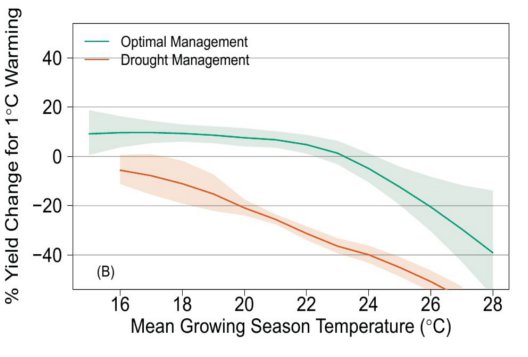Maize harvest to shrink under Global Warming
Posted on 16 March 2011 by Rob Painting
With global food prices at an all-time high, out comes a new study demonstrating once again, that global warming will generally have a very negative impact on food production. The study shows that warming of 1°C will lead to smaller maize (corn) harvests throughout Africa.
David Lobell (Lobell 2011) and his co-authors analysed a dataset of over 20,000 maize crop trials which had been carried out in Africa between 1999 and 2007. These trials had originally been designed for the purpose of testing new varieties of maize, and were especially useful for climate research because the trial locations covered a broad range of environmental conditions dotted throughout the continent. By comparing the trial data with that obtained from local weather stations, the authors found a relationship between warming, rainfall and falling crop yields.
Surprisingly, for a crop previously thought to be tolerant of warming, the study revealed that maize yield fell in crops exposed to temperatures above 30°C. At sites in ideally managed rain-fed conditions, for every degree day (degree day = a tally of hours over 30°C adding up to a 24 hour period) over 30°C yields fell 1% And for plots in managed, but drought conditions, the yield fell further, a 1.7% decline for every degree day over 30°C.
Next the authors calculated the likely effects on crop yields if average growing season temperatures at each site, were raised an additional 1°C, as shown below:

Figure 1 - Model estimate of yield impact of 1 °C warming for trials at different average growing-season temperatures. Shaded areas show an estimate of the 95% confidence interval.
The last step in the study was to compare what effect an increase of 1°C might have on future maize cropping in Africa. They discovered some cooler regions benefit from the warming, but the majority fare poorly. Under ideally managed rain-fed sites, projections show yield declined in 65% of areas where maize is currently grown. Under drought conditions this decline impacts all areas, with 75% of areas seeing yields fall by over 20%.
Due to the large scale and geographical extent of the trials, the study analysis represents the best understanding, to date, of how maize/corn harvests will fare in a warmer world. Regions such as Central and South America, where maize is a diet staple, are also going to be badly affected by rising temperatures and falling yields.
That hammering sound you may hear is another nail being driven into the coffin of the argument It's not bad: it is that bad.































 Arguments
Arguments
























 0
0  0
0 And the area currently growing maize.
And the area currently growing maize.
 John D - With regards to the matter of tolerance to warming. Warming is a very subjective term, do they mean, plus 5°C, 10°C, 20°C, 30°C ?
It appears you haven't even read the study. Please do so, and then maybe some rational discussion can ensue.
John D - With regards to the matter of tolerance to warming. Warming is a very subjective term, do they mean, plus 5°C, 10°C, 20°C, 30°C ?
It appears you haven't even read the study. Please do so, and then maybe some rational discussion can ensue.

 That is, taking the results from the trial data analysis and applying it to the areas presently under maize cultivation, 65% of areas see a decline. And under drought management (map f) all areas decline, with 75% of areas seeing declines of over 20%.
That is, taking the results from the trial data analysis and applying it to the areas presently under maize cultivation, 65% of areas see a decline. And under drought management (map f) all areas decline, with 75% of areas seeing declines of over 20%.
 Those are the take-home points. The fact that presently uncultivated areas will be negatively impacted too (seemingly your gripe) simply means that there doesn't seem to be any upside.
Those are the take-home points. The fact that presently uncultivated areas will be negatively impacted too (seemingly your gripe) simply means that there doesn't seem to be any upside.







Comments